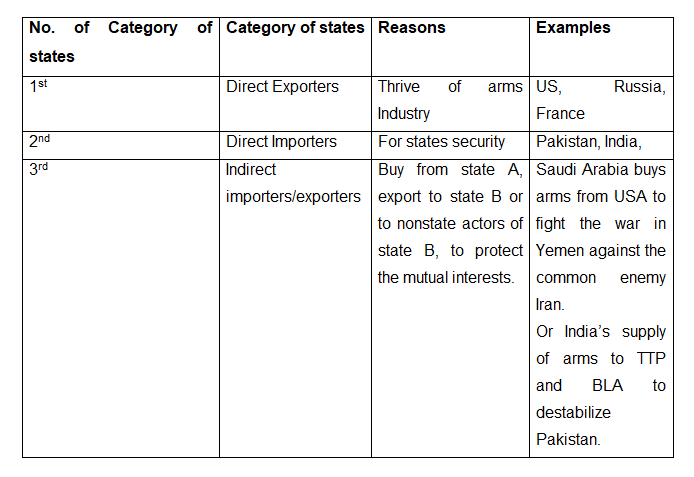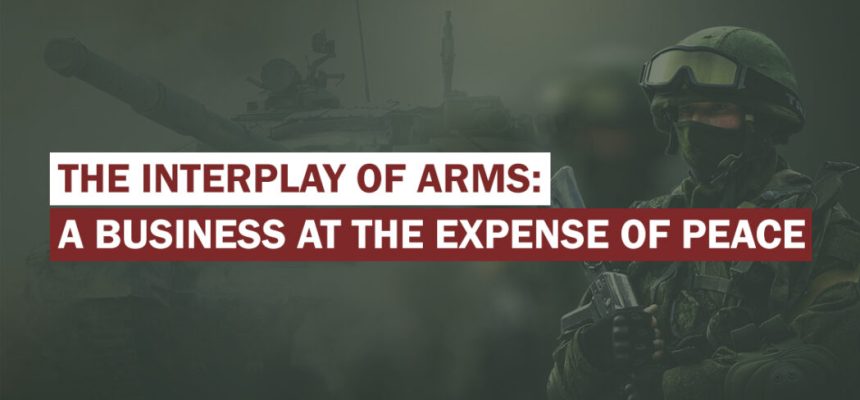The interplay of arms means the exchange of arms, the business of buying, and selling of them in the name of peace and security or balance of power. According to Machiavellian realism, when there is war in the neighborhood, a state must not sit back but should participate in the war and support the weaker state against the powerful state. In current times, States are more into indirect wars and beyond their territorial neighborhoods by supplying or selling their arms to weaker states in the other regions.
International transfer of Arms 2017-21
According to the SIPRI fact sheet of 2022, the international arms transfer fell by percentage of 4.6 in 2017-21 and was lower than 2012-16 due to covid-19 but remained 3.9% higher than it was in 2007-11. The five largest arms exporters which include USthe A, Russia, France, China a,nd Germany, accounted for 77% of all arms exports in 2017-21. Furthermore, 60 states supplied arms during the period of 2017-21.
The USA solely exported 39% of its arms of the total global export in 2017-21. It exported 43% of its arms to the Middle East. Overall, 53% of Middle Eastern states import arms from the USA. Among the top 10 states, there are 4 Middle Eastern states and 3 of them are USA arms recipients those Middle East states are Saudi Arabia, Qatar and United Arab Emirates. 33% of the USA arms were exported to Asian and Oceanian states from 2017 to 2021 whereas it also exported 17% of arms to the Africa in the same period.
After the USA, Russia remained the second largest arms exporter with 19% in 2017-21. 73% of the total arms of Russia were exported to four major states India, China, Egypt and Algeria. 61% of the Russian arms were exported to Asian and Oceanian states from 2017 to 2021. Russia supplied 20% arms to the Middle East and 14% to Africa.
France appeared as the 3rd largest supplier in the race of arms exporters. The total global share of arms exports of France remained 11% in 2017-21. India, Qatar and Egypt were the three largest recipients of French arms. France exported its arms to 65 states from 2017-21. However, the Middle East received 37% whereas, Asia and Oceania got 47% of French arms.
China exported 4.6% arms from the total global share. 79% of its arms were supplied to Asia and Oceania in 2017-21. Only Pakistan received 47% of the Chinese arms while China also delivered arms to 48 states in 2017-21.
Germany as the 5th largest arms exporter accounted for 4.5% of total global arms in 2017-21. It delivered major arms to 53 states. Asia and Oceania received 40% of the German arms, 29% arms of Germany went to the Middle East states and 18% to the European countries. However, Israel and India the two strongest allies of the US and the West are also not out of this race Israel accounted for 2.4% arms exportation while India supplied 0.2 % of arms.
Also Read: Pakistan vs India – The Defence Budget
The Recipients of Arms 2017-21
As per the SIPRI’s report, there had been 163 states of arms recipients in 2017-21. The five largest arms importers were India, Saudi Arabia, Egypt, Australia and China. These five states received 38% of total global arms imports and the top 10 states received 55%. Arms imported by South America in 2017-21 were at the lowest. Pakistan stands at number 8 and Israel at 14 for importing arms in 2017-21. The NATO imported 0.5% arms.
Interplay of Arms and types and types of states
As per my analysis there are three different types of states involved in the interplay of arms who are promoting their business interests at the cost of global peace.
1st- Direct exporters of Arms (USA, Russia, France, China, Germany
⦁ These states supply the arms because of their business industries.
2nd- Importers of Arms (these states are the ones who buy the arms)
⦁ Some importers-import for their personal security.
⦁ While, some of the importers either imports for their own state or to safeguard the interests of the exporters (mutual interests) in the region. For instance, Pakistan and China, Australia and US, the USA and India.
3rd- the Victim of Arms (against whom these arms are used)
⦁ Either from the external forces through border clashes or proxy wars
⦁ Or by internal non-state actors through civil war such as Indian export of arms to Myanmar or Sri Lanka.

Arms Exporters and the Umbrella of NATO
⦁ This is a cycle of arms interplay among the states, a large number of arms are exported from European countries and the USA to the Middle East mostly.
⦁ These all countries that manufacture the arms are under the umbrella of NATO. (USA, UK, and France three major countries with nuclear weapons are in the same boat while Israel and North Korea the two other largest importers of USA arms are the indirect supporters of NATO).
⦁ NATO as an organization also imports arms from its member countries and the member countries are the sellers of the arms to the rest of the world. In 2017-21 there had been observed a decrease in the Russian arms export due to the cut from India.
The interplay of Arms- the business of 1st world seed of conflict in the 3rd world
⦁ The countries that are armed exporters are in the line of first-world states and the countries which import mostly belong to the 3rd world stature. (The Middle East region, Africa, sub-Saharan region, and South Asia) are the regions with extreme poverty, underdeveloped, and facing structural and administrative issues led by political instability.
⦁ The US has its own bases around the Middle East, beyond its territorial sovereignty, protecting its self-interests while exploiting and violating the humanitarian interests of the Middle Eastern states at the same time selling its arms to the same region.
⦁ Hobbes put this situation well in his social contract theory by suggesting it as a war of all against all. The first world is the major beneficiary of this interplay who does not count their evil business as a problem but also has created watchdogs to overlook the humanitarian issues in the other regions.
Sun Tzu stated it rightly that the enemy of an enemy is also your friend. So, that’s how the states with bigger interests use the other states as their backyard to indirectly secure their interests. It is concluded that the humanitarian issues, political instability, proxy wars, and civil wars in the second and third worlds are not actually their issues but are the conflicts of powerful, and power-hungry states without any discrimination between Europe and Asia. Second or third world states always keep on fighting the war for their survival and security, buying weapons from the ones with whom they ally during their conflict to secure their territorial integrity. In this interplay of arms, the arms exporters secure their interests as well as their business against their adversary states at the same time.
Also Read: West Centrism in The International Order






